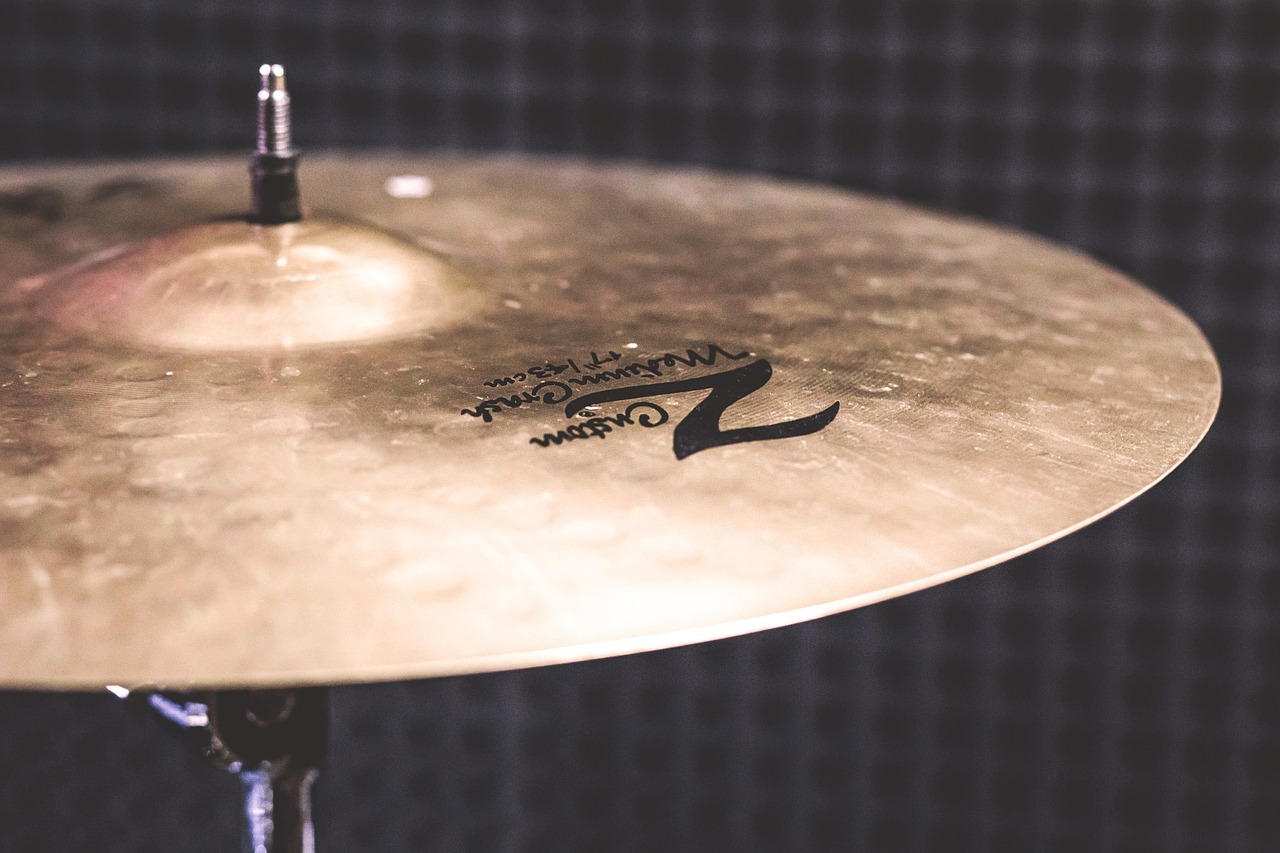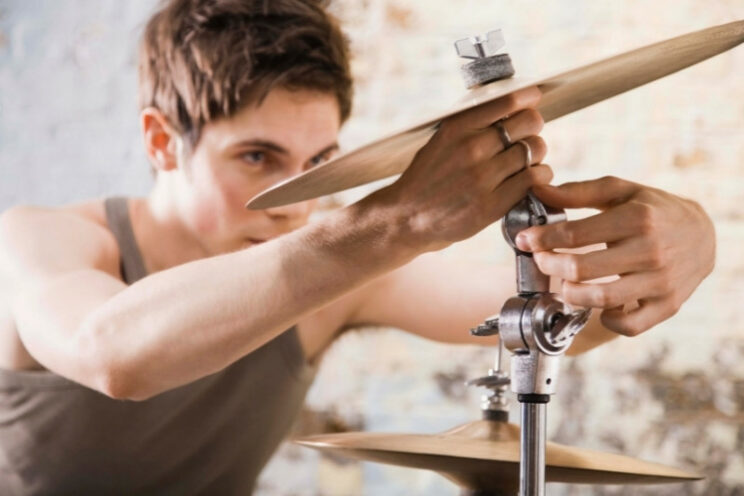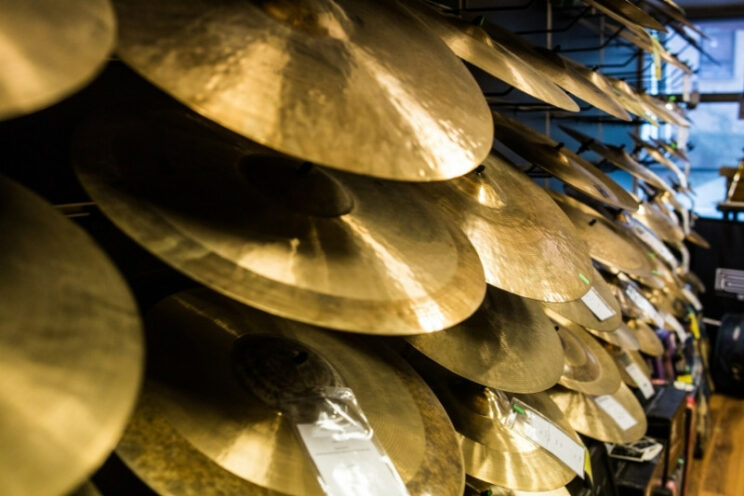
Suspended cymbals are great additions to use if you wish to portray a soft, elegant sound with minimal effort. They are widely used in orchestras to produce soft sounds with a gentle flow. Apart from this, they are also found on drum kits in the form of ride or crash cymbals.
Suspended cymbals can be played in different ways and they can produce a variety of sounds. Their uses range from rolling crescendos to crashes and general articulation. Bold, loud sounds can be obtained by making openings in their reach with drumsticks.
This article will show you exactly how to play them! You will find the basics, as well as some pro-level tips.
Contents
At a Glance
- Suspended cymbals can be played in a variety of ways using various types of drumsticks, each way producing a certain sound for particular settings.
- The basic stroke using a mallet is a great way to produce a crashing, slightly muffled sound with a lot of sustain. This is done by striking the ‘crash area’ of the cymbal.
- The basic stroke using a drumstick produces a more clear sound but it should be done with the shoulder of the drumstick. If you use the tip, this is known as ‘riding’ the cymbal (or way of playing a ride cymbal).
- If you use two mallets, strike the opposite sides of a cymbal, and gradually increase the intensity, you’ll get what is known as a ‘swell’ effect. Grabbing the cymbal after your strike it is known as a ‘choke’.
- Using a bass bow is also a way to play suspended cymbals. This produces a squealing car break sound.
- Another popular method is scraping a coin quickly and rapidly along the top ridges of a cymbal (I know this sounds weird). This way, you get the ‘zing’ sound.
How to Play Suspended Cymbals
The Basic Stroke (Mallet)
Strike the cymbal near its ‘crash area’, still on the main surface of the cymbal, but relatively close to the edge. The mallet will produce a crashing sound with a lot of sustain but will have a more muffled sound with less treble/attack compared to using a drumstick.
Play around with striking the suspended cymbal in different areas of the cymbal to get a feel for the different sounds that it can produce. You can choke the cymbal by grabbing it with your hand at any time to stop it from ringing.
The Basic Stroke (Drumstick)
When crashing a cymbal using either an orchestral suspended cymbal or when on the drum set, you should almost always use the shoulder of the drumstick.
There are two reasons for this:
- Using the tip of the cymbal would be known as ‘riding’ the cymbal, which gives a high-end ‘ping’ sound, which is not the sound we want when performing a crash stroke.
You can strike the cymbal more forcefully using the shoulder of the stick.
Swell
If you use two mallets and strike the opposite sides of a cymbal alternatively, you can also produce a roll or tremolo. If done right, this sound effect can be smooth and gradually increase in intensity, giving your music a tremendously dramatic effect.
Choke
Grabbing the cymbal with either one or both hands is known as choking the cymbal. This removes ringing from the cymbal and effectively dampens the sound and sustain of it.
This is very easy to do, but you should practice quickly moving between cymbal hits and chokes. If you’re playing swells with two mallets, then you should practice quickly moving between swells to grab the cymbals and make sure not to strike the stick or mallet against the cymbal.
Other Effect Strokes
This is a great video that explains some interesting sound effects that you can get from a suspended cymbal.
Using a Bass Bow
Another well-loved way to play a suspended cymbal is by shaping bass bows across the cymbal’s edge to obtain a squealing car break sound.
Using a Coin
Another popular method of playing these cymbals is scraping a triangle beater or a coin quickly and rapidly along the top ridges of a cymbal. This method is a popular choice if you want to obtain the “zing” sound.
Other possible options include brushes, knitting needles, fingernails, and the bowing edges of plates. You can think as creatively as you’d like with these instruments!
Some Tips When Playing Suspended Cymbals

While playing cymbals is no rocket science, there are a few tips and tricks that can help you obtain the maximum use of these instruments. These tips help you be more comfortable, creative, and productive while you use a suspended cymbal.
Stand Adjustment
Adjust the stand height to an optimum level according to your reach. A cymbal stand that is too high or too low can lead to more effort required from your side. You should place it somewhere from the waist to the mid-chest. Also, ensure that the cymbal is as near to a horizontal position as possible. It should ideally be parallel to the floor or the ceiling.
Always Carry Extras Felts, Washers, Nuts
If you are often traveling or moving around with your instruments, make sure to carry extra felts, protective washers, wing nuts, and plastic post insulators. These little parts, as insignificant as they may seem, can come in handy anytime, anywhere.
Keep the Cymbals Clean.
If you know anything about cymbals, you will see that dust accumulation can lead to physical and functional damage. It means that dirty cymbals are more prone to cracks and rust, and they also produce imperfect sounds. Overall, their functionality and performance are reduced by several folds.
Ensure you keep these instruments nice and clean using the appropriate primary products, if not the specialized ones.
Different Types of Suspended Cymbals

- The larger the cymbal, the louder the sound and the longer it sustains.
- Heavy cymbals generate a louder volume, improved stick articulation using drumsticks, and more cut.
- Smaller cymbals tend to have a higher pitched and less sustain.
The decision of which suspended cymbal you need to buy depends on several factors, including the kind of music you want to produce, the performer’s taste and preferences, and where you’re performing.
Suspended Cymbal Stands
Overall, there are two types of suspended cymbal stands
- Gooseneck cymbal stand
- Straight/boom cymbal stand
The former allows more resonation without dampening, and the latter gives more flexibility in terms of positioning.
What are the Uses of Suspended Cymbals?
Suspended cymbals are a popular part of orchestral settings. Their most common usage involves producing swells and rolled crescendos. Cymbals used on drum sets are also generally suspended on straight or boom cymbal stands.
Conclusion
As the name suggests, a suspended cymbal is a singular cymbal that you can play on its own instead of striking against another cymbal. You can use a stick or a beater to play these instruments, and they are a regular part of most drum sets.
Their structure is basic, and there’s nothing too fancy about a suspended cymbal other than the fact that it is self-sufficient and doesn’t rely on other cymbals.
The fact that they are suspended, and stand-alone allows them to vibrate freely and give you the maximum musical outcome. This cymbal style has been in trend since the 1900s and has only become more and more popular with time and improvement.
There are so many creative ways to use a single suspended cymbal. If put together with the right group of instruments and used the correct way, you can get the most use of this particular instrument. All the tips, tricks, and knowledge mentioned above will help you get a kick start and experiment with your suspended cymbals.







